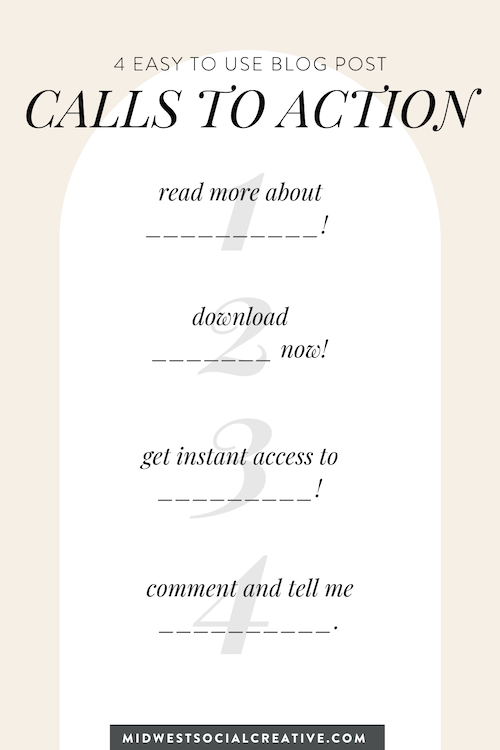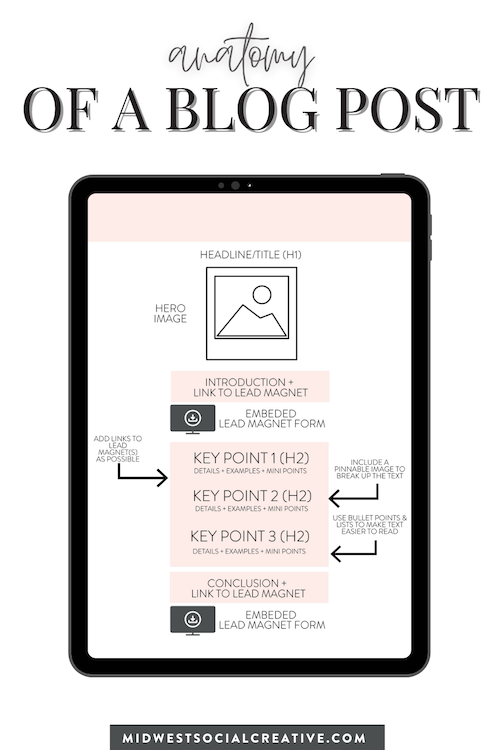The Anatomy of a Blog Post (That Converts)
Let’s face it, if you are spending any amount of time writing content that lives on your website - it needs to be good.
No, not just good - it needs to be effective. And if it’s not effective, then you might as well just be throwing your time (and money) out the window. (Good content doesn’t have to take forever, either - just see for yourself by watching my free content repurposing masterclass).
Let’s not do that.
Actually, I hate it when I see personal brands, service based solopreneurs, and content creators do this. Because it’s SO preventable. Time is a currency. Most likely you started your own business so you could have the flexibility and freedom to do what you want, when you want.
Time is important. Content is important. Tell me, can you relate to any of these?
- You feel like blogs take forever for you to write and even then you aren’t really sure you’re doing it right.
- You’ve been writing blog content for your website, but it’s not generating leads.
-You want to blog, but you want to do it right the first time.
>> Read this blog post on How to Start a Blog for Your Business. <<
If you said yes to any of them - you are in the right place!
It All Starts With A Catchy Title
Let’s face it, if you don’t have a steady stream of leads then you don’t have business. Your blog content should be an opening right into your funnel for lead generation and sales. But if no one is clicking on your posts to actually read them, it’s hard to do that now isn’t it?
Your business needs leads. So you need a catchy title. One that actually gets your readers to click and read.
The good news is that there are structures for blog titles that are proven to work. These structures will help you write titles that your readers (your ideal clients) will actually want to click on and read. So lucky for you, you don’t have to be left to your own devices to figure it out.
Here are a few examples you can use right away:
The ‘Listicle’: Like an article, but in list form. Readers love listicles. I bet you’ve clicked on a few listicles yourself. These are great because readers know exactly what to expect. A listicle is simple, clear, and easy to follow.
(ex: 5 Easy Ways to Save Time Cooking Dinner, 7 Brilliant Ideas for Growing Your Email List, 11 Ways to Promote Your Blog Post After Hitting Publish)The How To ______ : These are great when you are giving some sort of direction or doing a tutorial. Readers love the ‘how to’ post because they know exactly what they are going to learn by reading the post.
(ex: How to Save Time Cooking Dinner, How to Grow Your Email List, How to Promote Your Blog Posts After Hitting Publish)The Ultimate Guide to __________ : These titles are great when you have a comprehensive post that has a plethora of information. These are enticing to readers because they know these types of posts will have a lot of information to sift through and likely the best resource for whatever the topic is.
(ex: The Ultimate Guide to Saving Time When Cooking Dinner, The Ultimate Guide to Growing Your Email List, The Ultimate Guide to Promoting Your Blog Posts After Hitting Publish)
>> Neil Patel has a great article on writing irresistible headlines that’s packed full of ideas and formulas for writing great titles.
The Introduction
Your introduction should do 3 things.
1. It should give readers an idea of what to expect in your post.
You can make this a quick summary of the main points that are going to be covered. This is one of the reasons why I write my outlines first. With an outline already written, you’ll be able to quickly write an introduction summarizing the main points of the blog post.
2. It should highlight the pain point that your reader is experiencing.
In this case you can tailor your content to your services and the problems you solve for your clients. This is a great strategy, too, for pre-qualifying your readers and email subscribers by attracting the ones who are having the problem you solve.
3. It should propose to provide a solution to that problem.
Finally, your introduction should make it clear that your content will solve the readers problem, or show them how to solve their problem. This will keep the right readers on page, reading your content longer.
The Subheadings
The subheadings in your blog post are important because many readers are skimmers. They won’t read the details of your content, but instead will skim through to find the information they are looking for or to get the general idea of the post.
>> Read more about writing blog post outlines and subheadings here in this post. <<
There are also now more mobile readers than ever. If there is one thing readers do not enjoy is a wall of text when they open a link. So subheadings help break up the content in a way that allows for readers to scroll through and easily digest the information.
Subheadings also play a major role in optimizing your blog content for SEO. Your blog post subheadings serve as a framework for your content and Google will use this information to understand, index, and distribute the content.
Pro-tip for writing subheadings: Use the target keyword in a few of the subheadings, but not all. Keyword strategy and SEO are an entire topic on their own, but for the sake of this post, know that there is such a thing as keyword stuffing - you CAN put your keyword into a post TOO MANY times.
The Hero Image
The hero image is the image used to associate a visual to your content. Depending on the type of blogging you are doing, you might have just a few images (or maybe graphics) or you may have several.
For example, on my home decor niche blog - I typically have quite a few images included in each post. Obviously, home decor is very visual. I select one of the best images to designate as the hero image.
On the other hand, this blog doesn’t require quite so many images. But I do like to create a graphic for these posts. These graphics could be the hero image for the post.
The hero image will be used to promote the blog post across all platforms. Readers will visually connect with this image and it can also encourage readers to click through to read the post.
The hero image of your post is just as important as the blog title itself. So remember these key takeaways when it comes to visuals for your content:
-Image quality matters: keep images high resolution, light, and bright
-Images should be relevant to the content: I mean, duh - right?
-Use original photos (when possible) - Original is always better than stock as it builds trust with your readers
-Graphics matter: Keep them simple, on brand, and easy to read
If you are going to use stock imagery - then I highly recommend HauteStock.co - they have beautiful images that perfectly align with personal brands and service providers.
The Call to Action
Know your goal for your content going into creating it. Why are you writing this? Give that content purpose - a J.O.B.
If you’ve not read anything I’ve just shared and have been skimming up to this point - then stop here. This is easily one of the most common mistakes I see people make when writing their blogs.
A call to action can be as simple as asking for social shares or offering a lead magnet in exchange for readers' emails.
When you’ve taken the time to create content around your readers' pain points and provided solutions for that, it makes sense that readers might want to subscribe to your emails so they can continue to consume your content. Give them the opportunity. Make it simple for them.
The call to action you provide should align with the purpose you set for the content when you first started.
Here are some examples of simple Calls to Action to use:
Read more about _______________.
Download __________ Now!
Get Instant Access to _____________.
Comment and Tell Me _______________.
The Conclusion
This is the blog post end cap. Give it a final touch with a quick summary of the main points. Remind readers of their pain point that you are addressing and show how the post will solve their problem.
Some readers will skim right to the bottom and ONLY read the conclusion. You know these people - they’re the ones who like to read the last page of a book FIRST. You may even be one of them. No judgement here.
Make sure to get to the point and make it clear. This is your chance to drive the final point home.
You came here likely because you feel like your blog content takes too long to write (if you really want to cut your content creation time in half, click here for my content repurposing masterclass), or maybe you’re a perfectionist and you want to get the scoop on what to do before getting started writing blog content.
Whichever you can relate to, congratulations. You just read five years worth of research, trial and error in one blog post. I’ve laid out a simple, yet effective, anatomy of a blog post that will give you exactly what you need to include in each blog post and ultimately save you time and energy.
And in case you’re a “skip to the bottom” reader - here’s a summary of what the anatomy of a blog post includes:




